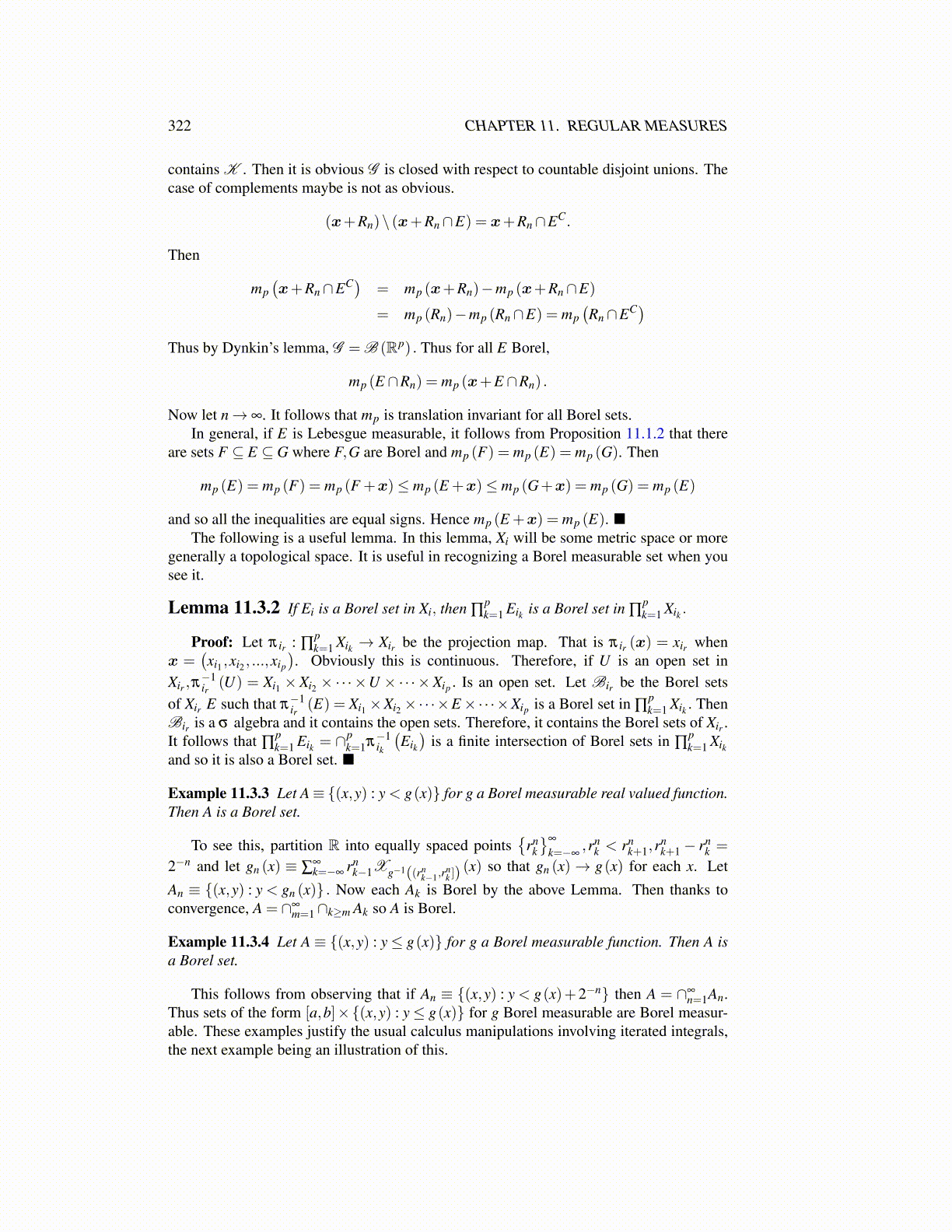
322 CHAPTER 11. REGULAR MEASURES
contains K . Then it is obvious G is closed with respect to countable disjoint unions. Thecase of complements maybe is not as obvious.
(x+Rn)\ (x+Rn∩E) = x+Rn∩EC.
Then
mp(x+Rn∩EC) = mp (x+Rn)−mp (x+Rn∩E)
= mp (Rn)−mp (Rn∩E) = mp(Rn∩EC)
Thus by Dynkin’s lemma, G = B (Rp) . Thus for all E Borel,
mp (E ∩Rn) = mp (x+E ∩Rn) .
Now let n→ ∞. It follows that mp is translation invariant for all Borel sets.In general, if E is Lebesgue measurable, it follows from Proposition 11.1.2 that there
are sets F ⊆ E ⊆ G where F,G are Borel and mp (F) = mp (E) = mp (G). Then
mp (E) = mp (F) = mp (F +x)≤ mp (E +x)≤ mp (G+x) = mp (G) = mp (E)
and so all the inequalities are equal signs. Hence mp (E +x) = mp (E). ■The following is a useful lemma. In this lemma, Xi will be some metric space or more
generally a topological space. It is useful in recognizing a Borel measurable set when yousee it.
Lemma 11.3.2 If Ei is a Borel set in Xi, then ∏pk=1 Eik is a Borel set in ∏
pk=1 Xik .
Proof: Let π ir : ∏pk=1 Xik → Xir be the projection map. That is π ir (x) = xir when
x =(xi1 ,xi2 , ...,xip
). Obviously this is continuous. Therefore, if U is an open set in
Xir ,π−1ir (U) = Xi1 ×Xi2 × ·· · ×U × ·· · ×Xip . Is an open set. Let Bir be the Borel sets
of Xir E such that π−1ir (E) = Xi1 ×Xi2 ×·· ·×E×·· ·×Xip is a Borel set in ∏
pk=1 Xik . Then
Bir is a σ algebra and it contains the open sets. Therefore, it contains the Borel sets of Xir .It follows that ∏
pk=1 Eik = ∩
pk=1π
−1ik
(Eik
)is a finite intersection of Borel sets in ∏
pk=1 Xik
and so it is also a Borel set. ■
Example 11.3.3 Let A≡ {(x,y) : y < g(x)} for g a Borel measurable real valued function.Then A is a Borel set.
To see this, partition R into equally spaced points{
rnk
}∞
k=−∞,rn
k < rnk+1,r
nk+1− rn
k =
2−n and let gn (x) ≡ ∑∞k=−∞
rnk−1Xg−1((rn
k−1,rnk ])
(x) so that gn (x)→ g(x) for each x. Let
An ≡ {(x,y) : y < gn (x)} . Now each Ak is Borel by the above Lemma. Then thanks toconvergence, A = ∩∞
m=1∩k≥m Ak so A is Borel.
Example 11.3.4 Let A ≡ {(x,y) : y≤ g(x)} for g a Borel measurable function. Then A isa Borel set.
This follows from observing that if An ≡ {(x,y) : y < g(x)+2−n} then A = ∩∞n=1An.
Thus sets of the form [a,b]×{(x,y) : y≤ g(x)} for g Borel measurable are Borel measur-able. These examples justify the usual calculus manipulations involving iterated integrals,the next example being an illustration of this.